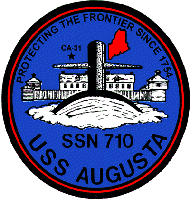 | |
| History | |
|---|---|
| Namesake | Augusta, Maine |
| Awarded | 10 December 1973 |
| Builder | General Dynamics Corporation |
| Laid down | 1 April 1983 |
| Launched | 21 January 1984 |
| Acquired | 5 December 1984 |
| Commissioned | 19 January 1985 |
| Decommissioned | 11 February 2009 |
| Stricken | 11 February 2009 |
| Homeport | Groton, Connecticut |
| Motto | Protecting The Frontier Since 1754 "Any Mission, Any Time" |
| Nickname(s) | "Gussie" |
| Honors & awards | Arctic Service, Navy Expeditionary, Battle "E", Navy Unit Commendation, Global War On Terrorism Expeditionary, Global War On Terrorism Service, Sea Service |
| Fate | Recycling completed on November 30, 2021 [1] |
| Badge |  |
| General characteristics | |
| Class & type | Los Angeles-class submarine |
| Displacement | 5,786 tons light, 6,927 tons full, 378 tons dead |
| Length | 110.3 m (361 ft 11 in) |
| Beam | 10 m (32 ft 10 in) |
| Draft | 9.7 m (31 ft 10 in) |
| Propulsion | S6G nuclear reactor |
| Speed |
|
| Complement | 15 officers, 115 enlisted |
| Sensors & processing systems | BQQ-5 passive sonar, BQS-15 detecting and ranging sonar, WLR-8 fire control radar receiver, WLR-9 acoustic receiver for detection of active search sonar and acoustic homing torpedoes, BRD-7 radio direction finder [2] |
| Armament | 4 × 21 in (533 mm) bow tubes, 10 Mk48 ADCAP torpedo reloads, Tomahawk land attack missile block 3 SLCM range 1,700 nautical miles (3,100 km), Harpoon anti–surface ship missile range 70 nautical miles (130 km), mine laying Mk67 mobile Mk60 captor mines |
| Service record | |
| Operations: | Iraq War (2003) |
USS Augusta (SSN-710), a Los Angeles-class submarine, was the first ship of the United States Navy to be named for Augusta, Maine. The contract to build her was awarded to the Electric Boat Division of General Dynamics Corporation in Groton, Connecticut on 31 October 1973 and her keel was laid down on 1 April 1983. She was launched on 21 January 1984 sponsored by Mrs. Diana D. Cohen, wife of U.S. Senator William Cohen and commissioned on 19 January 1985.